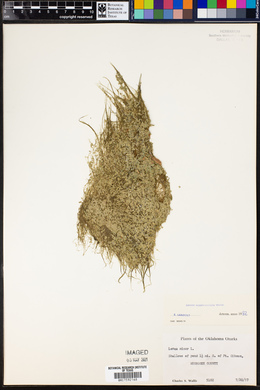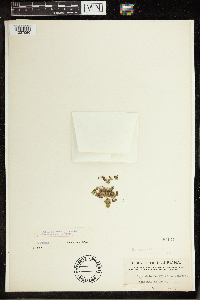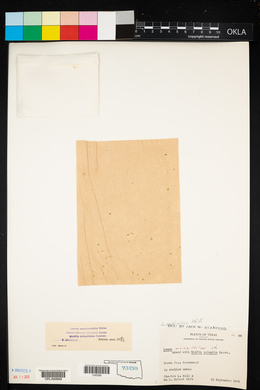Lemna aequinoctialis
|
|
|
|
Family: Araceae
Lesser Duckweed
[Lemna angolensis Welw. ex Hegelm., moreLemna paucicostata Hegelm., Lemna trinervis (Austin) Small] |
Roots to 3 cm; tip usually sharp pointed; sheath winged at base (wing 1--2.5 times as long as wide). Stipes small, white, often decaying. Fronds floating, 1 or 2--few, coherent in groups, ovate-lanceolate, flat, 1--6 mm, 1--3 times as long as wide, margins entire; veins 3, greatest distance between lateral veins near or proximal to middle; 1 often very distinct papilla near apex on upper surface and 1 above node; anthocyanin absent, no reddish color; largest air spaces much shorter than 0.3 mm; distinct turions absent. Flowers: ovaries 1-ovulate, utricular scale open on 1 side. Fruits 0.5--0.8 mm, not winged. Seeds with 8--26 distinct ribs, falling out of fruit wall after ripening. 2n = 40, 42, 50, 60, 80, 84. Flowering (frequent) spring--fall. Mesotrophic to eutrophic, quiet waters in warm-temperate to tropical regions; 0--1300 mm; Ala., Ariz., Ark., Calif., Fla., Ga., Ill., Ind., Iowa, Kans., Ky., La., Miss., Mo., Nebr., N.Mex., N.C., Okla., S.C., Tenn., Tex., Va., Wis.; West Indies; Central America; South America; s Eurasia; Africa; Atlantic Islands; Indian Ocean Islands; Pacific Islands; Australia. Some authors did not distinguish between Lemna aequinoctialis and L. perpusilla and used the latter name for both species.
Plant: Small aquatic plant Leaves: FRONDS floating on the surface of the water, single or 2 to a few cohering in small groups, ovate, 1-6 mm long, 1-3 times as long as wide, flat, without a green stalk but with a very small white stipe that often decays; margins entire; nerves 3, the greatest distance between the laterals near the middle, papillae near the apex and above the attachment point of the root mostly very distinct; anthocyanin absent; air spaces much smaller than 0.3 mmroot mostly very distinct; anthocyanin absent; air spaces much smaller than 0.3 mm root up to 3 cm long; sheath winged at the base, the tip normally sharply pointed; no distinct turions present Flowers: frequent, l-ovulate, the small utricular scale open on one side Fruit: with dry pericarp,0.5-0.8 mm long, not winged; SEEDS: with 8-26 distinct ribs Misc: -Mesotrophic (with moderate amounts of nutrients) to eutrophic (with high amounts of nutrients), quiet waters; below 1200 m (4000 ft); May-Oct Notes: root up to 3 cm long REFERENCES: Landolt, Elias. 1992. Lemnaceae. Ariz.-Nev. Acad. Sci. 26(1)2. Aquatic herb Flowers: occurring frequently, very tiny, lacking sepals and petals, with two stamens, surrounded by a membranous scale open along one side. Fruit: bladder-like (utricle), thin-walled, 0.5 - 0.8 mm long, unwinged, with seeds having eight to 26 distinct ribs and separating from fruit wall when ripe. Roots: to 3 cm long with a pointed tip, the root sheath wing 1 - 2.5 times as long as wide. Plant body: not differentiated into stem and leaves, floating solitary or as a few attached, green, 1 - 6 mm long, one to three times as long as wide, flattened, egg-shaped to lance-shaped, three-veined, with one distinct projection near tip of upper surface and one smaller projection above the root. Air spaces inside the plant body are much smaller than 0.3 mm. Similar species: Lemna aequinoctialis, Lemna perpusilla, Lemna turionifera, and Lemna minor have two to four veins and tend to be wider than 1.5 mm. Lemna turionifera and L. minor can be distinguished from L. aequinoctialis by having round-tipped roots that are usually longer than 3 cm and plant bodies that are tinged with red. Lemna perpusilla has a winged root sheath that is two to three times as long as wide and one to three projections above the root attachment that are larger than the projection near the tip. Flowering: spring to fall Habitat and ecology: Rare in quiet waters of the Chicago Region. Most records in North American are probably aquarium escapes. Occurence in the Chicago region: non-native Etymology: Lemna is the Greek name for a water weed. Aequinoctialis means "from the regions near the equator." Author: The Morton Arboretum FNA 2000 Duration: Perennial Nativity: Native Lifeform: Forb/Herb General: Perennial, free-floating aquatic herb with roots to 3 cm long; roots sheathed, the sheath winged at base with a wing 1-2.5 times as long as wide; fronds solitary or coherent in groups of 2 to a few, connected by stipes that are small white, and often decaying. Leaves: Fronds (structures that look like leaves but are developmentally both stem and leaf tissue) tiny, floating, ovate-lanceolate, flat, 1--6 mm long, with entire margins and 3 veins, the greatest distance between lateral veins being near or proximal to middle; with one often very distinct papilla near apex on upper frond surface and a second papilla above the node; lacking anthocyanin or a reddish color; largest air spaces much shorter than 0.3 mm; distinct turions absent. Flowers: Unisexual, with 1 pistillate and 2 staminate flowers; ovaries 1-ovulate, the utricular scale open on one side. Fruits: Follicles 0.5--0.8 mm long, not winged. Seeds with 8--26 distinct ribs, falling out of fruit wall after ripening. Ecology: Found in mesotrophic to eutrophic quiet waters, in warm-temperate to tropical regions, below 4,500 ft (1372 m); flowers frequently, from spring--fall. Distribution: US southeast, southern plains, and southwest; in the southwest it is found in s CA, s AZ, s NM, and TX. Notes: Lemna is a genus of tiny, free-floating aquatic plants, which usually form loose mats or clusters of very small (ca. 2-3 mm) -leaves- that float on the water surface, with trailing roots that are thin, transparent, and not attached to the ground. There is a long history of this taxon; see Cronquist et al. 1977 for a great encapsulation. Generally difficult to tell Lemna apart in the field but this species is distinguished by its winged root sheath; seeds with 8-26 distinct ribs; and leaves (fronds) 1-3 times as long as wide, with 3 veins. Unlike some Lemna, this species can be regularly found flowering. Some authors do not distinguish between Lemna aequinoctialis and L. perpusilla, and use the latter name for both species Ethnobotany: Unknown Etymology: Lemna is from the Greek limnos, lake or swamp; aequinoctialis refers to the equinox, and possibly refers to the flowering time. Synonyms: Lemna angolensis, Lemna paucicostata Editor: AHazelton 2015 |
|
|
|






























































































